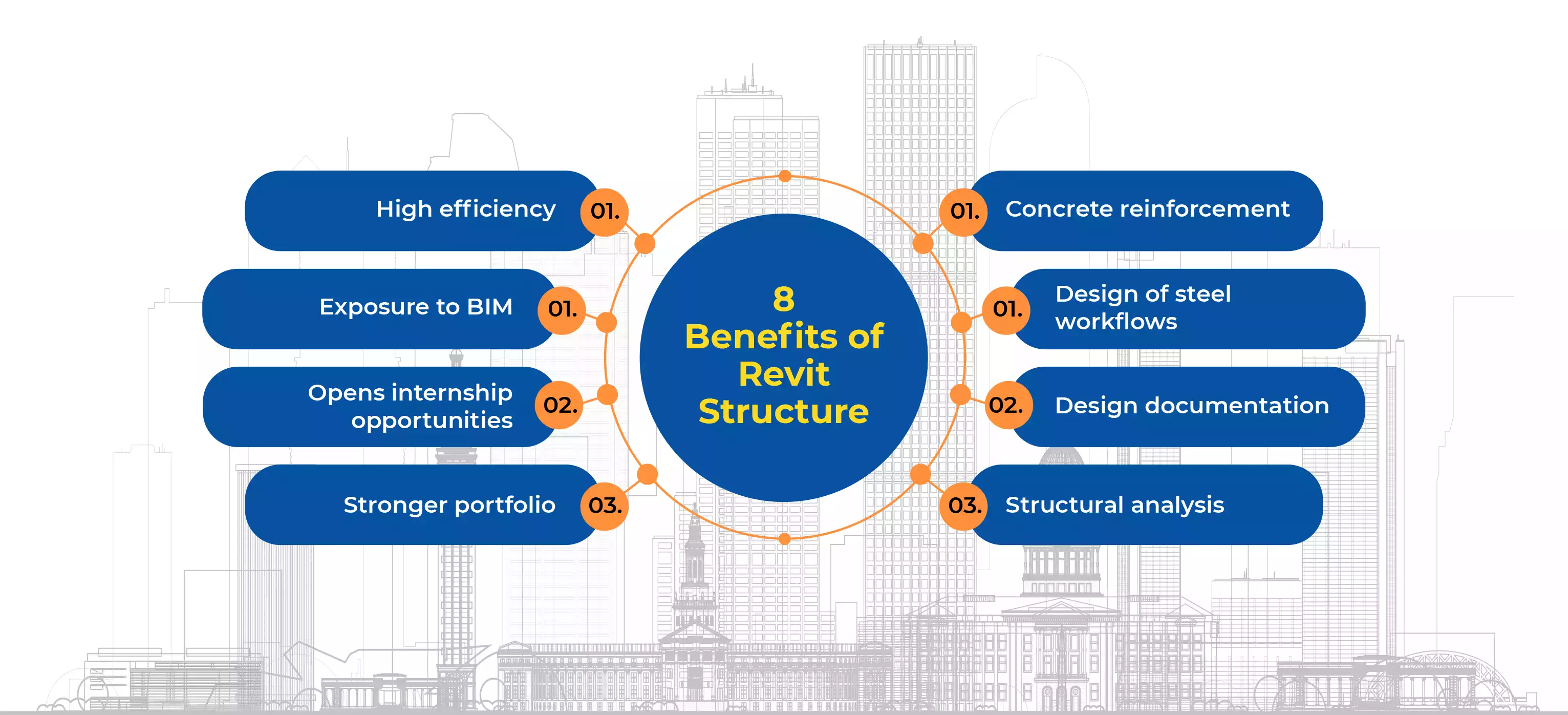 Shaheen M
Jan 25, 2024
Shaheen M
Jan 25, 2024

The Revit Structure helps to improve multi-discipline coordination of Structural Design Documentation, Minimize Errors, and enhance collaboration between Structural Engineers and extended Project Team Members, such as Architects, MEP Engineers, and Owners. From conception to execution to maintenance, Revit software allows you to manage every aspect of a construction project.
Revit also has features that cover the entire life cycle of a project and allows multi-functional teams to operate with a single, up-to-date data set. Engineers praise the platform for its interoperability, complex data, and scheduling capabilities. On top of that, Revit is a cloud-based platform, which allows teams to collaborate efficiently and in real time.
Also Read Similar Post: Why Should you Learn Revit Structure?
Features Of Revit Structure
Revit Structure is a powerful BIM software that provides many features and tools for structural engineers. Given below are some of the key features of Revit Structure that make it such a powerful tool;
Also Check Out: Revit Structure Skills For Your Resume
Revit Structure is used by architects and engineers to design and develop plans for new construction projects. Revit Structure also has several benefits for its users. The following are the top 8 benefits of learning Revit structure.
Precision and accuracy are two qualities praised for Revit Structure. You can create a rudimentary blueprint as a structural engineer and continue to build a typical collection of building designs. Models can be easily previewed by clients before being made upright will enable you to identify problems, if any, sooner in the design process.
For instance, some clients have specific requirements about the potential environmental impact of their structures. This issue is readily resolved with the Revit structure. It provides you with analytical tools to guarantee the longevity of your model from the moment you begin developing it.
Revit was built for BIM methodology and it helps designers design, visualize, and collaborate so that they get the benefits of interconnected data within a BIM Model. Workflow is channelized easily as it utilizes information from a common database. From the initial conceptual design to the structural engineering model to drafting, whatever changes that any parties make will be updated throughout.
Every member has the access to the information they need as Revit Structure is cloud-integrated. Such is the intelligent BIM model that Revit runs. BIM improves team collaboration and management, a major reason why you should learn BIM. BIM model training can be availed in Revit with Revit Structure Training in Dubai.
Also Read: Guide to Choose Best BIM Software
Internships are the stepping stones to larger opportunities. If you've noticed most companies offering internships to students demand Revit experience right in their second year. Why is this? Because Revit gives you an edge over other student peers in manipulating design data with a BIM model. Companies look for internship candidates who are accustomed to applying real-world Revit knowledge to their projects. So, the earlier you learn Revit the better will be your prospects. If you want to become an expert in Revit Architecture, an internship is the right choice start!
Also Read: Guide to Career in Revit Architecture
An engineer proves his/her ability by showcasing their portfolio. Wondering how Revit Structure can boost one? If there's an ultimate problem solver for construction designers, it's Revit Structure. It cuts down the cost of repetitive tasks, and manual paper documentation. Additionally, you get a feature-rich toolset to work with other construction software using Autodesk CAD-like Autodesk Revit MEP and Autodesk Revit Architecture. Altogether learning Revit Structure enhances productivity eliminating tedious work. Increased productivity is an indication of a strong portfolio.
Also Check Out: Key Skills to Master Revit MEP
Model 3D concrete reinforcement in an advanced BIM environment. You may develop thorough reinforcement plans and shop drawings using rebar bending schedules.
Integrate the processes for designing and detailing steel. Increase the level of information in the Revit model's definition of the steel connectors' design purpose.
The documentation for steel and concrete designs should be more precise and detailed. In model elements, the information from the building database is immediately presented.
Conduct structural analysis while building the physical model in Revit, then export it to programs for analysis and design.
Individuals can use Revit to enhance their jobs and performance, from CEOs and project managers to architects and even field personnel. Revit includes various features that make it particularly useful for structural engineers because it provides capabilities that assist with each step of a construction project. Let's look at some particular benefits in particular that this BIM platform provides for these experts.
Revit enables this by offering an intelligent model that is used in real time by all stakeholders. Because Revit is a native BIM solution, all work is completed on a single, continuously updated file. Structural engineers may verify that no data is lost and reduce the chance of errors by utilizing such linked workflows.
Additionally, Revit enables structural engineers to quickly communicate information to on-site workers and other stakeholders. By using Revit you essentially save a ton of time, money, and logistical challenges due to the regular updating of all project sheets, views, and models, the possibility of misunderstandings and human errors is greatly reduced.
Revit contains features made especially for 3D modelling buildings and other complicated structures. In Revit, every model has a complete set of parameters that can be changed and updated. Everyone engaged may make better decisions and enhance the working process overall by using this data to guide them. The smart building models that Revit creates incorporate crucial project data that can be accessed at any time and from any location.
The parametric features of Revit are beneficial for structural engineers. You may streamline procedures, decrease risk, and save time by establishing dependencies between several data types. For instance, the corresponding reinforcing specifications, steel schedules, and dimensions will automatically update if the width of a floor slab is changed.
For structural engineers, the capacity to produce intricate, realistic 3D models has unquestionable benefits. Bidirectional views can be created in Revit in a variety of ways, including 3D details, schedules, and sections. Even better, all of these views share a model and file and operate on the same set of data. Any modifications you make to the 3D model will instantly update all those views as well.
You can also improve such bidirectional views by including 2D components and dimensions. You can create views that truly assist you to optimize your work, as well as reduce errors and scheduling concerns, by adding additional sheets, formwork, and position.
With Revit, you can quickly add intelligent 3D reinforcement to concrete precast or cast-in-place items. The reinforcement modelling can be used with the sheet, 2D views, and 3D views. If you modify the model, dependent reinforced objects, such as fabric sheets and rebar, will keep their dependencies and be immediately updated.
Also Read Similar Post: Advantages of Learning Revit Structure
There are many benefits to learning Revit Structure. Revit Structure is a powerful tool that can help you streamline your structural design process and improve your coordination with other disciplines. In addition, Revit Structure can help you create more accurate models and documents, saving you time and money in the long run. Whether you're a beginner or an experienced user, Revit Structure is worth learning.
Explore the Revit Training Courses Offered By Edoxi Training Institute in various countries and locations in the Middle East.
| Country | UAE | Oman | Qatar |
| Course Location | Dubai | Muscat | Doha |

Shaheen is an expert Corporate Trainer in BIM, Architecture and CAD with over 8+ years of experience. His expertise includes advanced 3D BIM Modeling, Architectural Drafting and Detailing, and Interior & Visualization Design. Additionally, he offers tailored training programs specific to various industry needs. He has trained over 5,000 professionals in advanced modeling and design techniques.
Shaheen’s training expertise spans HVAC Design, Electrical Design, Tekla, Lumion, STAAD.Pro, AutoCAD 2D & 3D and Civil 3D. Through his hands-on teaching approach, Shaheen ensures that students engage with real-world architectural projects. His corporate training portfolio includes some of the top architectural companies in Dubai. He has trained professionals from universities, including Sharjah University, Ajman University and Canadian University, and companies such as KhanSaheb, HCTS, Silver Pool Technologies and many more. His practical industry experience enriches the training program's real-world value.